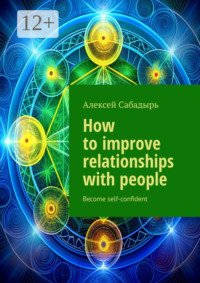Czytaj książkę: «How to improve relationships with people. Become self-confident»
Illustrations Leonardo ai
© Алексей Сабадырь, 2025
ISBN 978-5-0064-4705-9
Created with Ridero smart publishing system
Chapter 1: In a World of noise: from hearing to understanding
In our noisy world, overflowing with information and constant distractions, the art of active listening has become a valuable and rare gift. We often hear words but do not understand their true meaning. We think about our response before the other person has finished speaking. We miss important details, losing contact with the person on the other side.
Active listening: the key to mutual understanding
Active listening is not just hearing sounds, but carefully delving into the meaning of words and non-verbal cues. It is the ability to create an atmosphere of trust and safety, where a person can open his heart and express his thoughts without judgment.
Why is active listening important?
Strengthening relationships: when we listen carefully to each other, we feel understood and respected.
Resolving conflicts: active listening helps us understand the other person’s position before expressing our own.
Building trust: when we truly listen to someone, we show them that they matter to us.
Effective communication: active listening makes our conversations more productive and focused.
The first steps to active listening:
Full attention: put your phone away, turn off the TV, focus on the person you are talking to.
Eye contact: look into the person’s eyes, but not too intrusively.
Non-verbal cues: nod your head, maintain eye contact, smile when appropriate.
Paraphrasing: repeat the other person’s key points in your own words to make sure you understand them correctly.
Asking questions: clarify points you don’t understand, ask questions that will help you better understand the other person.
Empathy: try to understand the other person’s feelings, put yourself in their shoes.
Active listening is a skill that requires practice. Don’t expect to become a master of this art right away. Be patient and you will see how your relationships with people become stronger and more harmonious.
Chapter 2: Managing the storm within
Emotions are an integral part of our lives. They add vibrancy, color our experiences, and help us navigate the world. But sometimes they can get out of control, clouding our judgment and preventing us from building harmonious relationships.
Managing emotions Is the key to effective communication
Learning to manage your emotions is the key to effective communication. When we control our feelings, we can express ourselves calmly and respectfully, even in difficult situations. We become more self-confident and better understand others.
How to master emotional literacy?
Recognizing emotions: learn to identify what you are feeling and give names to your emotions.
Breathing exercises: deep breathing helps you calm down and relieve tension.
Relaxation techniques: meditation, yoga, and walking in nature help reduce stress and calm the mind.
Self-Analysis: ask yourself: What caused this emotion? How does it affect you? What can you do to change it?
Positive approach: focus on the good things in life, practice gratitude.
Contain negative emotions: do not let anger, fear or resentment control your actions. Pause before speaking or acting.
How to manage emotions in communication?
Show empathy: put yourself in the other person’s shoes, try to understand their feelings.
Assertive communication: express your thoughts and feelings clearly and respectfully, without resorting to accusations and criticism.
Finding a compromise: look for solutions that suit all participants in the dialogue.
Darmowy fragment się skończył.
